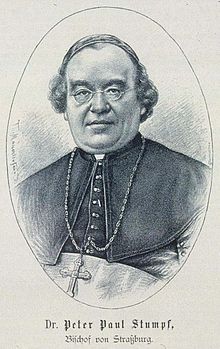Peter Paul Stump

Peter Paul Stumpf (born September 21, 1822 in Eguisheim , † August 10, 1890 in Strasbourg ) was the 98th bishop of the diocese of Strasbourg from 1887 until his death .
Life
He was the son of the winemaker Jean-Baptiste Stumpf and Marie Ange Willmann. He grew up in modest circumstances and attended the secondary school of the Collège de Colmar, later the seminary (Petit Seminaire) in Lachapelle and then the Grand Séminaire de Strasbourg and was ordained a priest in Strasbourg in 1847 by Gaspard Mermillod and Joseph Georg von Ehrler .
After his ordination he was first vicar in Molsheim in 1848 . Between 1849 and 1853 he was vicar at the Strasbourg cathedral .
In 1853 he followed his spiritus rector, Professor Burg, and left the diocese as a Spiritan . In the same year he became a teacher at the Séminaire des Colonies in Paris. A year later he was appointed director of studies in the French seminary in Rome by his superiors, and in 1859 he became director of this seminary.
In 1864 he was called back to Strasbourg at the request of the bishop, incardinated and took over the management of the Grand Séminaire . In 1876 he became vicar general and was particularly responsible for questions of education.
On May 13, 1881, he was appointed titular bishop of Caesaropolis and coadjutor of Bishop André Raess with the right to succeed him. Taking into account the state of health of Raess, he was appointed diocesan administrator of the archdiocese in 1883 .
Because of the increasing quarrels about the approximately 120 church buildings of the Reformed Church of Alsace and Lorraine and the Church of Alsace and Lorraine , which were used as simultaneous churches , in 1884 Stumpf founded the Œuvre des églises mixtes , a church building fund to collect money for the construction of Catholic churches the simultaneous use of Protestant churches would be superfluous. Stumpf's successor, Fritzen, who was very committed to this cause, was able to greatly increase the number of Catholic parish churches and by 1914 reduce the simultaneous use of Protestant churches to 64 cases.
A favorite project of Stumpf was the purchase and redesign of Egisheim Castle with the construction of the St. Leo IX Chapel in his home town.
literature
- Franz Heinrich Reusch: Stump, Peter Paul . In: Allgemeine Deutsche Biographie (ADB). Volume 36, Duncker & Humblot, Leipzig 1893, p. 751.
Remarks
- ↑ By order of Louis XIV from 1684, all Lutheran and Reformed parishes must make the choir of their church buildings available for Catholic masses if there is no Catholic church in their parish but at least seven Catholic families are resident. In the 21st century, around 50 Protestant churches in Alsace and the Moselle department are still in use as simultaneous churches .
- ↑ a b Cf. “Simultaneum” , from: Wiki-protestants.org , accessed on February 26, 2013.
Web links
| personal data | |
|---|---|
| SURNAME | Stump, Peter Paul |
| BRIEF DESCRIPTION | Bishop of Strasbourg |
| DATE OF BIRTH | September 21, 1822 |
| PLACE OF BIRTH | Eguisheim |
| DATE OF DEATH | August 10, 1890 |
| Place of death | Strasbourg |

